Club Nacional de Football
Club Nacional de Football (Spanish pronunciation: [kluβ nasjoˈnal de ˈfutbol]) is a sports institution from Uruguay, founded on 14 May 1899 in Montevideo, as a result of the fusion between Uruguay Athletic Club and Montevideo Fútbol Club.[3] Although its main focus is football, the club hosts many other activities including basketball, futsal, tennis, cycling, volleyball, and chess.
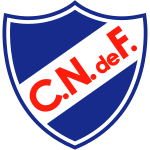 | ||||
| Full name | Club Nacional de Football | |||
|---|---|---|---|---|
| Nickname(s) | Bolso, Tricolores (Tricolors), Bolsilludo, Albos (Whites)[1] | |||
| Founded | 14 May 1899 | |||
| Ground | Gran Parque Central | |||
| Capacity | 34,000[2] (expanding to 40,000) | |||
| Chairman | José Decurnex | |||
| Manager | Gustavo Munúa | |||
| League | Primera División | |||
| 2019 | Primera División, 1st (champions) | |||
| Website | Club website | |||
|
| ||||
In domestic tournaments, Nacional has won the Primera División title 47 times, most recently in the 2019 season. Domestic cups honours include Copa de Competencia (8 times) and Copa de Honor (7 times), among others.
At international level, Nacional has won 22 titles, nine of them recognised by FIFA and CONMEBOL,[4] including three Copa Libertadores. In this tournament, Nacional is the all-time leader with 553 points.[5] Nacional has also won all three Copa Intercontinental it has competed in, becoming the second three time world champion in 1988. In addition, Nacional is the only Uruguayan team to have won the Copa Interamericana (two times)[6] and the Recopa Sudamericana. In the latter competition Nacional won the inaugural edition in 1989.[7] Besides, Nacional won four Copa de Honor Cousenier,[8] three Copa Aldao[9] two Tie Cup,[10] and one Copa Escobar-Gerona,[11] all of them organized jointly by the Argentine and Uruguayan Associations.
Nacional is identified with the white, blue and red colours inspired by the flag of Uruguay's national hero José Gervasio Artigas.[12] While the club hosts some games at Montevideo's Estadio Centenario, Nacional plays most of its home matches at the Parque Central, located in the La Blanqueada neighbourhood and popularly known as El Parque, where on 13 July 1930 Belgium and the United States played one of the two opening games of the 1930 FIFA World Cup, and where Argentina and Brazil, among others, made their debut in the FIFA World Cup. Parque Central was also the only venue in the 1923 and 1924 edition of the Copa América.[13]
Nacional has fierce rivalries with many clubs, notably with cross-town team Peñarol, in clashes known as El clásico del fútbol uruguayo.[14] Along with Peñarol, Nacional has never been relegated from the top flight of Uruguayan football.
According to CONMEBOL, Nacional was the Uruguayan team with the best international performance in the 2007–2012 period.[15] Also, according to IFFHS, it was the best Uruguayan team of the 2001–2010 period and the seventh best team in South America.[16]
In February 2013, Nacional reached 60,000 associates[17]
History
Foundation and first years

Nacional is a result of the fusion between Montevideo Football Club and Uruguay Athletic Club, 14 May 1899. It was decided there that the club's flag should include the three colours (red, blue and white) historically connected to José Gervasio Artigas, Uruguay's national hero. The club's uniform was mostly red and blue. In 1900 Nacional included the Club Defensa and its players, and started playing at the Estadio Gran Parque Central. That same year four clubs governed by foreigners (Albion F.C., CURCC, Uruguay Athletic Club and Deutscher F.K.) founded the Uruguay Association League. Nacional's petition to be included was dismissed on the thought that criollo clubs and their players lacked category. However, the League's clubs had to admit Nacional in 1901, after the club was invited to join the Argentinean League, due to their impressive performances in a number of friendly matches. In 1902 Nacional won their first Uruguayan Championship. The red jersey was substituted by the white jersey in 1902.
In September 1903 Nacional fully represented the Uruguay national football team and beat Argentina 3–2, winning the first international match ever (between national teams) in the history of Uruguayan football (the first international club match ever, was won by Albion over Argentine team Retiro A.C. 3–1 in 1896 in Buenos Aires). In 1905 Nacional won its first international title, the Copa de Honor Cousenier.
In a general assembly which took place in 1911, the populist majority led by club president José María Delgado obtained a victory over the elitist minority which resulted in an institutional transformation: the club opened its doors to players from lower classes, such as Abdón Porte, who would eventually become one of the club's biggest symbols, playing in Nacional until his premature death in 1918.
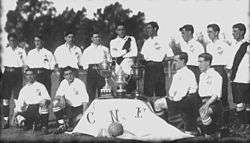
Nacional's players started developing already around 1900 a new playing style that introduced a less physical and more imaginative game, made out of fast combinations and frequent dribblings. Magariños says: "The action of these teams [the British-Uruguayan teams, that is] was conducted according to the purest and standardized virtues of British sport: positional play, long passes, furious shots, and strong physical play. The body was used as a weapon, both offensively and defensively. (...) Nacional, formed mainly by smaller and faster players (...) abandoned the physical confrontation that was allowed back then, and chose to play according to their own possibilities. They chose to perform dribblings, fast and short passing, very fast sprints, and a hectic activity in the pitch."[[18]]
After winning the 1912 championship, they won the 1915 Triple Crown (Tri-championship), which included the three major domestic and international tournaments of that time: Primera División, Tie Cup and Copa de Honor Cousenier. Nacional would go on to win the first Copa Uruguaya en propiedad (meaning they were the first club to win three championships in a row), by winning both the 1916 and 1917 championships. The other championships obtained during the amateur era were the 1919, 1920, 1922, 1923 and 1924.
On the international level, Nacional won three Copa Aldao in 1916, 1919 and 1920, three Copa de Honor Cousenier in 1915, 1916 and 1917, and two Tie Cup in 1913 and 1915.
International tours and success
After two very successful initial decades in the national league of Uruguay and at the regional level, Nacional became the foundation of Uruguay's first international success at the world level. In 1924, Nacional contributed players (Mazzali, Urdinarán, Scarone, Romano, Zibechi and Pascual Somma) for Uruguayan national representative that won the Summer Olympics in Paris. Nacional made also a substantial contribution to the Uruguayan teams of 1928 and 1930, Olympic and World champions respectively. Nacional is the only Uruguayan club that contributed players to every Uruguay national team that has won international tournaments.
In 1925, due to the success of Uruguay and players from Nacional in the 1924 Summer Olympics, Nacional was invited to make an extensive European tour, playing 38 matches over six months. During that tour, Nacional played against both national squads and professional club teams from 9 European countries. Nacional won 26 matches, tied 7, and lost 5, scoring 130 goals and allowing 30. An estimate of 800,000 tickets were sold during that tour,[19] which is considered the largest tour in the history of world football.
In 1927, Nacional made an American tour, with similar results to the ones obtained in the European adventure made two years before, with 16 wins, 2 ties and 1 loss.
The show team: 1932–43
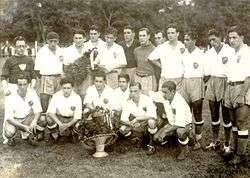
In 1932, football became professional in Uruguay and Nacional formed a team that would be nicknamed La Máquina Blanca (The White Machine). The team scored 28 goals in the first four games of the 1932 season. In 1933 Nacional won its 12th. first division title, repeating the next year. The 1933 championship is remembered as the longest ever, since it ended in November 1934, after a series of final games against Peñarol, the last won by Nacional by 3–1 with 3 goals by Héctor Castro.
In 1938, Argentine footballer Atilio García came to the club. That same year Nacional won the "Nocturno Rioplatense". Between 1939 and 1943, coached by former player Héctor Castro Nacional won the Quinquenio de Oro (five consecutive championships from 1939 to 1943). Some highlights of those times was the 5–1 victory over Peñarol, with 4 goals by Atilio García. Nacional also made an outstanding campaign in the 1941 season, winning all the games disputed (20/20). In those five years the team played 96 Copa Uruguaya games, won 77, tied 9 and only lost 10, made 318 goals and allowed 108.
Nacional's superiority over Peñarol during this era is best exemplified by some particular feats:
- Between 1938 and 1943 there were 23 clásicos, with 18 victories for Nacional and only 4 for their rivals.
- On 14 December 1941 Nacional obtained the largest win in the history of Uruguayan Clásico, defeating Peñarol 6 – 0. (That year, Nacional won all 20 games of the championship.)
- On 23 November 1943 Nacional won their tenth Campeonato uruguayo clásico in a row.
Notable players of that period include Atilio García (all-time Nacional's top scorer, also Uruguayan Clásico all-time top scorer with 34 goals, eight times Uruguayan Champion, eight times league's highest scorer); Aníbal Paz (nine times Uruguayan champion and World Champion defending Uruguay in 1950); Schubert Gambetta (nine times Uruguayan Champion and World Champion in 1950); Luis Ernesto Castro (seven times Uruguayan Champion); Aníbal Ciocca (eight times Uruguayan Champion), Eugenio Pato Galvalisi (seven times Uruguayan Champion), Roberto Porta (six times Uruguayan Champion), Bibiano Zapirain (six times Uruguayan Champion).
International achievements
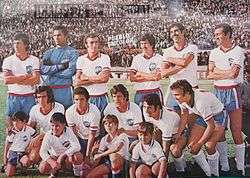
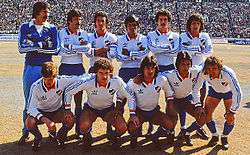
Nacional's international reputation relied on the tournaments played during the first half of the 20th century in the Río de la Plata region, where the most important international tournaments in America were played before the Copa Libertadores was created. Historical rivalries with longtime enemy Peñarol and famous Argentinian teams like Boca, River Plate, Racing, Independiente, San Lorenzo, Rosario Central and Newell's Old Boys, among others, were established in those championships.
Nacional participated in the Libertadores for the first time in 1962, when they were defeated in the semi-finals by Peñarol. They got to the Finals in 1964, but lost to Independiente, and in 1967 to Racing.
With President Miguel Restuccia, Nacional formed the basis of a team that would eventually achieve its goal, with players such as Ubiña, Mujica, Montero Castillo, Espárrago, Cascarilla Morales, Brazilian goalkeeper Manga, Cubilla and the great Argentinean striker Artime. In the 1969 Libertadores, after defeating Peñarol in semi-finals, Nacional lost its third Finals, this time against Estudiantes de La Plata.
In 1971, coached by Washington Etchamendi, Nacional finally won its first Copa Libertadores, beating Estudiantes de La Plata in Lima, Peru. That year, Nacional won its first World Club title, the 1971 Intercontinental Cup, in memorable matches against Panathinaikos from Greece, with goals from striker Luis Artime. Panathinaikos played because the reigning European champion, AFC Ajax, refused to play due to the violent conduct common among top South American teams during this period. The following year, Nacional won its first Copa Interamericana, defeating Cruz Azul from Mexico.
During this period, Nacional also regained supremacy in the domestic field, obtaining four Uruguayan Championships in a row (1969, 70, 71 and 72), keeping an unbeaten match record against classic rivals Peñarol: between March 2, 1971 and January 31, 1974, Nacional remained undefeated in 16 games.
Nacional repeated its achievement in the Copa Libertadores in 1980, beating Internacional from Brazil in the finals. After becoming South American champions, Nacional won the Intercontinental Cup for the second time, defeating European champions Nottingham Forest from England 1–0, with goal by forward Waldemar Victorino. That year Nacional also won the Uruguayan championship.
Nacional won its third copa Libertadores in 1988, beating Argentine side Newell's Old Boys 3–0 in the Estadio Centenario, with goals from Ernesto Vargas, Santiago Ostolaza and Hugo De León. That same year, Nacional would contest its third Intercontinental Cup. In a breath-taking final against Dutch side PSV Eindhoven coached by Guus Hiddink, Nacional would win in the penalty shootout after the game ended 2–2 with two goals by Ostolaza (the second one scored at the last minute of overtime). The next year, Nacional won its second Copa Interamericana, this time beating C.D. Olimpia from Honduras, and the Recopa Sudamericana, defeating Racing from Argentina.
Recent history
In most of the 90s the club suffered a financial crisis and obtained few sportive results. It won the 1992 Championship with great performances by Julio César Dely Valdés and Antonio Vidal González. After Peñarol's second Quinquenio (1993–97) Nacional's Directive board changed: returning President Dante Iocco brought back club's idol Hugo de León as coach to prevent Peñarol from obtaining the hypothetical Sexenio. That year Nacional won the 1998 Campeonato Uruguayo by winning both short tournaments Apertura and Clausura. This was the first time any club achieved this feat since that system was implemented in 1994, having been repeated only by Danubio in 2006–07 season.
Maintaining the basis of its squad, Nacional dominated the national ambitus for three consecutive years (2000, 2001 and 2002.)
In 2005 Nacional decided to restore its stadium, the Estadio Gran Parque Central, where the team has returned to host most of their games instead of state-owned Estadio Centenario.
Nacional is the most successful team since the beginning of the century, having won also the 2005, 2005–06, 2008–09, 2010–11, 2011–12, 2014-15 and 2016 championships.
2016 was the 46th Uruguayan Championship won by Nacional. It was a one-round tournament, which marked the return of the domestic calendar to fit the calendar year instead of the European calendar.

Nacional qualified for the 2018 Copa Libertadores. It will be Nacional's 45th appearance in the tournament, and the twenty second consecutive (absolute record in the cup's history).
After Martín Lasarte's resignation, the club's board appointed former star and reserve team coach Alexander Medina as the principal team's new coach.[20]
Stadium
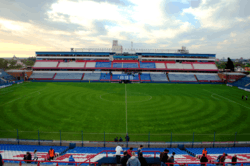
Nacional plays most home games at its own stadium, the Montevideo-based 26,500 (and growing)[21] capacity Gran Parque Central (soon to be 30,000), first built in 1900. It is located in "Quinta de la Paraguaya" a historic place where a Oriental revolutionary leader José Gervasio Artigas was named "Jefe de los Orientales" in 1811.[22] In recent decades the stadium had not been used very often because Nacional played at the national stadium Estadio Centenario, sharing it with Peñarol, but in 2005 Nacional decided to the return to the Gran Parque Central. Since then, its ongoing renovation has allowed Nacional to play most of its home domestic matches there, as well as many international matches. High-risk matches and derbies are still played at the Centenario.
The four stands of the stadium are named in memory of four symbolic figures:
- the official stand, which includes press and VIP boxes is called José María Delgado, after one of the club's most important Presidents.
- the largest stand, opposed to the Delgado, is the Atilio García, after Nacional's all-time top scorer.
- the Abdón Porte, after one of Nacional's biggest symbols: a player who after being relegated from the team shot himself dead in the center of the field. This is the stand where the organized supporter group attends.
- the Héctor Scarone, after another historical striker, nicknamed el Mago (the Wizard).
After the completion of the second tire of the Atilio García, Abdón Porte and Héctor Scarone stands, the current work involves the construction of a corner structure joining the Atilio García and Porte stands. Future additions include a third tire on the three aforementioned stands.
Supporters
The First "Hincha"

.jpg)
The Spanish word to describe football fans is "hincha", and it was coined by Nacional fans. An employee of Nacional of the early 20th century, Prudencio Miguel Reyes, was famous for his continuous support to the team. The other fans that attended the games started to call him by one of his duties: pumping air to the balls (in Spanish: "inflar" the balls, in Uruguay: "hinchar" the balls). Within a few games, Reyes was known as the "hincha" of Nacional. This is the origin of a word that is frequently used by Spanish speakers worldwide.[23]
"The biggest flag in the world"
In June 2013, Nacional supporters displayed for the first time the biggest flag of the world as they called the emblem during a match vs. Deportivo Toluca played for the 2013 Copa Libertadores. The flag cost US$50,000, previously collected amongst the supporters La Banda Del Parque [24] The flag, with a dimension of 600 m long by 50 m height,[25] entered the Guinness World Records as "the biggest flag ever seen in a football match".[26]
The flag also weighed 5,000 kg, with 400 persons being needed to move it.[27] La Banda Del Parque
Nicknames
Nacional is nicknamed "tricolores" ("three colours"), "albos" ("whites") and "bolsilludos", later shortened to "bolsos" ("bolsillo" being the Spanish word for pocket – Nacional used to play with a jersey that had a pocket on the chest). "La blanca" (another reference to the white jersey) is less common.
Players
Current squad
- As of 28 February 2020
Note: Flags indicate national team as defined under FIFA eligibility rules. Players may hold more than one non-FIFA nationality.
|
|
Records
- Most appearances:
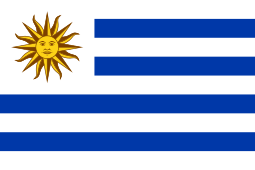
- Most years with the club:

- All-time greatest goalscorer:

- Longest time without conceding a goal:

World Champion players
In 1924, Nacional was the club that contributed more players to Uruguay's team that won the Olympic gold medal in football of that year. It happened again with Uruguay's teams of 1928 and 1930, Olympic and world champions respectively, in which Nacional contributed the majority of players. Nacional is the only Uruguayan club that contributed players to every Uruguay national team that went on to win international tournaments.[28]
Below, the list of Nacional players that were part of Uruguay's Olympic and world champions teams.
Notable coaches
|
|
|
Honours
Domestic


- Primera División (47)
- Copa Competencia (8): 1903, 1912, 1913, 1914, 1915, 1919, 1921, 1923
- Copa de Honor (7): 1905, 1906, 1913, 1914, 1915, 1916, 1917
- Torneo de Honor (17): 1935, 1938, 1939, 1940, 1941, 1942, 1943, 1946, 1948, 1955, 1957, 1958, 1959 (shared), 1960 (shared), 1961, 1962 (shared), 1963
- Torneo Competencia (13): 1934, 1942 (shared), 1945, 1948, 1952, 1958, 1959, 1961, 1962, 1963, 1964 (shared), 1967 (shared), 1989
- Torneo Cuadrangular (8): 1952, 1954, 1955 (Shared), 1956, 1958, 1961 (Shared), 1964, 1967
- Liguilla (8): 1982, 1990, 1992, 1993, 1996, 1999, 2007, 2008
- Liga Mayor (3): 1975, 1976, 1977
- Campeonato Nacional General Artigas (2): 1961, 1962
- Supercopa Uruguaya (1): 2019
Other
Official tournaments but played once:[29]
- Torneo Fermín Garicoits (1): 1965
- Torneo Ciudad de Montevideo (1): 1973
- Torneo 50º Aniversario de Colombes (1): 1974
- Torneo Campeones Olímpicos (1): 1974
- Campeonato Estadio Centenario (1): 1983
International
- Copa Libertadores (3): 1971, 1980, 1988
- Intercontinental Cup (3): 1971, 1980, 1988
- Copa Interamericana (2): 1971, 1988
- Recopa Sudamericana (1): 1989
- Copa Aldao[30] (3): 1916, 1919, 1920[31]
- Copa de Honor Cousenier[30] (4): 1905, 1915, 1916, 1917
- Tie Cup[30] (2): 1913, 1915
- Copa de Confraternidad Escobar-Gerona[30] (1): 1945[32]
- Copa del Atlántico[33] (1): 1947[34]
International friendlies
Youth Tournaments
- U-20 Copa Libertadores (1): 2018
- Copa Santiago de Futebol Juvenil (2): 1989, 1994
Other sports
Basketball
Nacional participates in the tournaments organised by the Uruguayan basketball federation Federación Uruguaya de Basketball (known as FUBB) since 1932. The club won the championships of 1935 and 1937. Nowadays, Nacional takes part in the Liga Uruguaya de Basketball, Uruguayan basketball first division.
- Campeonato Federal (2): 1935 y 1937.
- Liguilla (2): 1982 y 1983.
Cycling
Nacional participates in the championships organised by the Uruguayan Cycling Federation Federación Ciclista del Uruguay since its beginnings. The club won the most important competitions in several occasions: Vuelta Ciclista del Uruguay and Rutas de América, individually and by teams. Nowadays, Nacional cycling team has the presence of Milton Wynants, winner of a silver medal for Uruguay in the 2000 Summer Olympics.
Vuelta Ciclista del Uruguay (9)
- Teams (6): 1960, 1961, 1968, 1994, 1999, 2000[36]
- Individual (3)
- Leandro Noli: 1939
- Jorge Correa: 1968
- Milton Wynants: 1996
Rutas de América (6)
- Teams (5): 1993, 1994, 1995, 2000 y 2001.[37]
- General Individual (1)
- Gustavo Figueredo: 2000
Mil Millas Orientales (1)
- General Individual (1)
- Tomás Correa: 1960
Vuelta Ciclista del Paraguay (2)[38]
- Teams (1): 1998
- Individual (1)
- Gustavo Figueredo: 1998
Rugby
Nacional have announced that they will forming a rugby union section to compete in the 2021 season of the Súper Liga Americana de Rugby.[39]
Tennis
Nacional has a lot of tennis courts in Parque Central, behind the stand Talud Abdón Porte, in which several stages of the tournaments organised in Uruguay are disputed. In 2005, the club had the honour of holding various games played by Uruguay in the American Zone II of Davis Cup.
Volleyball
Nacional has its volleyball court in Parque Central, in the gymnasium of Jaime Cibils street. In that stadium, the club plays its home games of the championships organised by the Uruguayan volleyball federation Federación Uruguaya de Vóleibol in every category.
Men (9)
- Campeonato Federal (1): 1954.
- Super Liga Nacional de Voleibol (3): 2008, 2009,[40] 2010.
- Campeonato Uruguayo Livosur (1): 2010.
- Torneo Apertura Livosur (2): 2009, 2010.
- Torneo Clausura Livosur (2): 2006, 2008.
Women (4)
- Campeonato Federal (3): 1955, 1960, 1961.
- Torneo Abierto ciudad de Minas: 2011
Women's football
Nacional was part of the tournaments organised by the Department of Feminine Football of the Uruguayan Football Association, since its establishment in 1996, winning the Campeonato Uruguayo in 1997 and 2000. The club disaffiliated in 2005 and returned to the league in 2009 ending third in the annual standings. They won the championship in 2010 and 2011–2012. Internationally, Nacional played in various South American championships.
Official national tournaments (12)
- Campeonato Uruguayo (4): 1997, 2000, 2010, 2011/2012.
- Torneo Apertura (4): 1997, 1999, 2000, 2011.
- Torneo Clausura (2): 2002, 2012.
- Torneo Preparación Joseph Blatter (2): 2010, 2011.
Other national tournaments (3)
- Triangular Día Internacional de la Mujer (ciudad de Minas, departamento de Lavalleja) (1): 2011
- Triangular Internacional Diego Rodríguez (Rivera) (1): 2011
- Triangular Triangular Confraternidad en Artigas (1): 2012
International friendly tournaments (1)
- Cuadrangular Internacional Ciudad de San Nicolás de los Arroyos (Argentina) (1): 2011
Youth tournaments (3)
- Torneo Apertura Sub 18 (1): 2004
- Torneo Preparación Bicentenario Sub 16 (1): 2011
- Triangular Internacional Diego Rodríguez Sub 16 (1): 2011
Futsal
Nacional participates in the championships organised by de Futsal Delegated Commission of the Uruguayan Football Association. The club won the Uruguayan league title in various occasions and is nowadays the Uruguayan champion. Internationally, Nacionals main achievement is the second place in the South American Futsal Cup Copa Libertadores de América de Futsal in 2003.
Affiliate FIFUSA – AMF / FUdeFS
Official national tournaments (10)
- Campeonato Metropolitano (8): 1990, 1991, 1992, 1993, 1994, 1995, 1996 y 1997.
- Campeonato Nacional de Clubes Campeones (2): 1994, 1997.
Official international tournaments(1)
- Campeonato Sudamericano de Clubes Campeones: 1996.
Affiliate FIFA / AUF
Official national tournaments (23)
- Campeonato Uruguayo (7): 1998, 2000, 2002, 2003, 2005, 2008 y 2009.
- Campeonato Metropolitano (5): 2002, 2004, 2005, 2007 y 2009.
- Copa de Honor (Liguilla Pre Libertadores) (3): 2006, 2010, 2011.
- Campeonato Apertura (5): 1998, 2000, 2005, 2008 y 2009.
- Campeonato Clausura (3): 1998, 2002 y 2009.
Official international tournaments (1)
- Ganador de la Zona Sur de la Copa Libertadores de Futsal: 2003.[41]
References
- "Nacional en búsqueda de un triunfo en la Copa Libertadores". Archived from the original on 19 March 2014. Retrieved 20 March 2014.
- "Archived copy". Archived from the original on 20 December 2014. Retrieved 28 June 2014.CS1 maint: archived copy as title (link)
- "Uruguay – Foundation Dates of Clubs". Rsssf.com. Retrieved 31 March 2012.
- Las competiciones oficiales de la CONMEBOL on Conmebol website, 19 Ago 2015
- "All-time league table".
- "Copa Interamericana". Rsssf.com. 25 February 2011. Retrieved 31 March 2012.
- "Recopa". Rsssf.com. 29 February 2012. Retrieved 31 March 2012.
- Honor Cup on RSSSF
- Copa Aldao – Campeonato Rioplatense overview
- Cup Tie on RSSSF
- Copa de Confraternidad Escobar – Gerona on RSSSF
- "Nacional entró con la bandera de Artigas – Diario EL PAIS – Montevideo – Uruguay". Ovaciondigital.com.uy. Retrieved 31 March 2012.
- "000webhost.com – free web hosting provider". Parquecentral.com.uy. Archived from the original on 19 June 2010. Retrieved 31 March 2012.
- "FIFA.com – Peñarol – Nacional, una rivalidad única". Es.fifa.com. Retrieved 31 March 2012.
- "Conmebol". Conmebol. Retrieved 31 March 2012.
- "IFFHS HISTORY : SOUTH AMERICA'S CLUB OF THE FIRST DECADE (2001-2010)". IFFHS. Retrieved 4 July 2018.
- "La pasión no para: 4.000 nuevos socios". Ovación. Retrieved 25 February 2013.
- 3 Magariños Pittaluga, "Del fútbol heroico", Montevideo, 1943, p. 74 ss.
- Giovannini, Eduardo (2003). La Gira de Nacional por Europa en 1925. Montevideo: Nacional Digital. ISBN 9974-39-500-3.
- "Apenas resta un paso". Ovación. Retrieved 27 December 2017.
- "Obras". Club Nacional de Football. Archived from the original on 10 April 2011. Retrieved 14 April 2011.
- "La quinta de La Paraguaya, cuando Artigas fue nombrado Jefe de los Orientales". Diario La Republica. Retrieved 14 April 2011.
- Amando de Miguel. "Amando de Miguel – El incierto origen de las palabras". Libertad Digital. Retrieved 31 March 2012.
- "Nacional goleó a Toluca y se clasificó" Archived 8 April 2013 at the Wayback Machine, Infobae
- "Nacional desplegó la bandera más grande del mundo", Clarín, 5 Ago 2013
- "Nacional vs Toluca al récord Guinness", FOX Sports, 4 Apr 2013
- "Nacional estrena bandera gigante" Archived 24 November 2012 at the Wayback Machine, El Observador, 23 Dec 2012.
- "1904". Nacionaldigital.com. Retrieved 31 March 2012.
- "Títulos" on Nacional website, retrieved 23 Jun 2015
- Official titles but still not recognised by CONMEBOL. – (source: Torneos on CONMEBOL website, retrieved 11 Dec 2014
- Copa Aldao on RSSSF
- Title shared with Boca Juniors
- Títulos internacionales Archived 2 June 2009 at the Wayback Machine on Nacional website
- Copa del Atlántico, RSSSF.com
- Copa Montevideo 1953–1971
- "Vuelta Ciclista del Uruguay – History at Uruguay Cycling Federation". Archived from the original on 2 February 2009. Retrieved 14 June 2011.
- "Winners at Uruguay Cycling Federation". Archived from the original on 21 March 2012. Retrieved 14 June 2011.
- "Paraguayan Cycling Federation". Archived from the original on 21 November 2010. Retrieved 14 June 2011.
- http://www.americasrugbynews.com/2019/04/28/super-liga-sudamericana-to-begin-in-march-2020/
- "Página oficial de la FUV". Uruvoley.org.uy. Archived from the original on 25 March 2012. Retrieved 31 March 2012.
- Conmebol.com (2 July 2003). "Futsal: Nacional de Uruguay ganador de la Zona Sur". Retrieved 9 July 2009.
